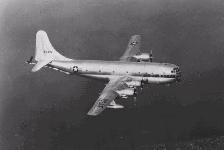
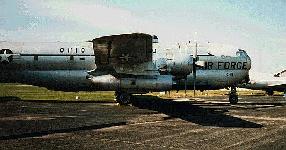
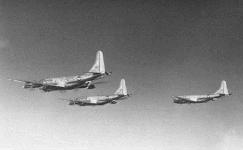

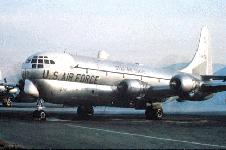
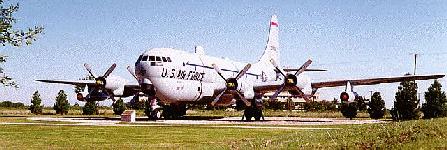
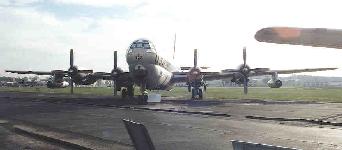





The C-97 was the cargo/transport version of the B-29. Fatten the B-29's fuselage, use the same wings, tail and engines and you have a cargo plane. The prototype first flew in 1944 with the first production C-97A in 1949. Boeing also developed a practical in-flight refueling boom about the same time. Previously, the Air Force had experimented with a trailing hose technique with some success, but Boeing's boom changed the state of the art overnight.
Very soon the basic C-97 Stratofreighter became a KC-97 Stratotanker refueling bomber aircraft, usually a B-47 Stratojet. The tanker version (KC-97) was introduced in 1950 using the "flying boom" refueling system and all subsequent USAF contracts were for tankers, having the capability of serving as a heavy cargo aircraft without removing the refueling gear. After 1956, USAF KC-97s were gradually replaced by KC-135 jet tankers, but some were modified for continued use in other roles. The KC-135 jet powered aircraft, with a greater capacity, took over the tanker role along with its name, Stratotanker. The KC-97 did all the pioneering work.
How did a piston engine tanker refuel a faster jet bomber? It "tobogganed". The refueling connection would be made high up and then the bomber and tanker flew "downhill" together enabling the tanker to pick up more speed. The KC-97L had an extra jet engine mounted under both wings which gave it the added speed required for flight and takeoff. This enabled it to refuel jet bombers without tobogganing. The KC-97 carried both AVGAS and jet fuel. The AVGAS was used to power its radial Piston engines while the jet fuel was carried to power its two jet engines and to be off loaded to its receivers.
In 1964, selected aircraft were returned to tanker configuration (KC-97L) primarily for the Air National Guard. Two jet engines were added to increase speed and altitude, making the tankers more compatible with high performance jet aircraft. Although the last USAF C/KC-97 was retired in 1973, it remained in use in the AFRes and ANG until the late 70s.
Specifications |
|
| Manufacturer: | Boeing Aircraft Company |
| Designation: | KC-97 |
| Version: | L |
| Nickname: | Stratofreighter |
| Type: | Tanker |
| Crew: | Five - Pilot, Copilot, Navigator, Flight Engineer and Boom Operator |
| Length: | 117' 5" |
| Height: | 38' 4" |
| Wingspan: | 141' 2" |
| Empty Weight: | 82,500 lbs |
| Max Weight: | 175,000 lbs |
| Load | More than 9,000 gallons of fuel |
| No. of Engines: | 6 |
| Powerplant: | 4 - Pratt & Whitney R-4360-59 Wasp Major radial piston engines (and)
2 - General Electric J-47-GE-23 turbojet engines |
| Horsepower (each P&W): | 3,500 |
| Thrust (each GE): | 5,200 lbs |
| Cruise Speed: | 300 mph |
| Max Speed: | 375 mph |
| Service Ceiling: | 30,000 ft |
| Range: | 2,300 mi |
| Armament | none |







